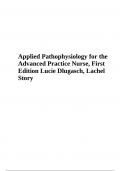Exam (elaborations)
Test Bank - Applied Pathophysiology for the Advanced Practice Nurse 1ST Edition Lucie By Dlugasch, Lachel Story | Complete 2023/2024
Course
Applied Pathophysiology for the Advanced Practice
Institution
Applied Pathophysiology For The Advanced Practice
Test Bank - Applied Pathophysiology for the Advanced Practice Nurse 1ST Edition Lucie By Dlugasch, Lachel Story | Complete 2023/2024.
A 50-year-old man is having an acute myocardial infarction and will be administered recombinant
tissue plasminogen activator (t-PA). The medication activates plasm...
[Show more]
Preview 4 out of 146 pages
Uploaded on
August 30, 2023
Number of pages
146
Written in
2023/2024
Type
Exam (elaborations)
Contains
Questions & answers
Institution
Applied Pathophysiology for the Advanced Practice
Course
Applied Pathophysiology for the Advanced Practice
$32.49
100% satisfaction guarantee
Immediately available after payment
Both online and in PDF
No strings attached
Applied Pathophysiology for the Advanced Practice Nurse, First Edition Lucie Dlugasch, Lachel Story Applied Pathophysiology for the Advanced Practice Nurse, First Edition Lucie Dlugasch, Lachel Story Chapter 3 Assessment Quiz Copyright © 2021 by Jones & Bartlett Learning, LLC, an Ascend Learning Company Import Settings: Base Settings: Brownstone Default Information Field: Complexity Information Field: Ahead Information Field: Subject Information Field: Title Information Field: Feedback Information Field: Taxonomy Information Field: Objective Highest Answer Letter: E Multiple Keywords in Same Paragraph: No NAS ISBN13: 9781284182903, add to Ahead, Title tags Chapter: Chapter 03 - Quiz Multiple Choice 1. Which of the following coenzymes is(are) necessary for normal red blood cell nuclear maturation and DNA synthesis pathway? A) Vitamin D B) Folate C) Calcium D) Vitamin B12 (cobalamin) E) Both folate and vitamin B12 (cobalamin) Ans: E Complexity: Easy Ahead: Hematopoietic System Subject: Chapter 3 Title: Hematopoietic Function 2. von Willebrand factor is directly involved in: A) platelet adhesion and aggregation. B) platelet production. C) formation of the fibrin clot. D) clot dissolution. Ans: A Complexity: Easy Ahead: Hematopoietic System Subject: Chapter 3 Title: Hematopoietic Function 3. __________ are two important cofactors necessary in the coagulation cascade. A) Fibrinogen and von Willebrand factor B) Thromboxane A2 and calcium C) Fibrin and thrombin Applied Pathophysiology for the Advanced Practice Nurse, First Edition Lucie Dlugasch, Lachel Story Chapter 3 Assessment Quiz Copyright © 2021 by Jones & Bartlett Learning, LLC, an Ascend Learning Company D) Fibrinogen and calcium Ans: D Complexity: Easy Ahead: Hematopoietic System Subject: Chapter 3 Title: Hematopoietic Function 4. A 50-year-old man is having an acute myocardial infarction and will be administered recombinant tissue plasminogen activator (t-PA). The medication activates plasminogen in order to: A) decrease platelet adhesion. B) increase clotting time. C) promote fibrinolysis. D) promote coronary vasodilation. Ans: C Complexity: Easy Ahead: Hematopoietic System Subject: Chapter 3 Title: Hematopoietic Function 5. A 25-year-old woman comes in complaining of night sweats and at times gets chills. She is losing weight unintentionally. She has no other complaints. A lymph node in her neck that measures 3 cm and is painless is palpated. The most likely diagnosis is: A) non-Hodgkin lymphoma. B) Hodgkin lymphoma. C) Burkitt lymphoma. D) multiple myeloma. Ans: B Complexity: Moderate Ahead: Diseases of the White Blood Cells Subject: Chapter 3 Title: Hematopoietic Function 6. In Hodgkin lymphoma, B cells can become defective as a result of: A) T-cell inactivation of B cells. B) premature apoptosis due to lack of differentiation. C) errors in immunoglobulin gene arrangements. D) enhanced conversion into plasma B memory cells. Ans: C Complexity: Easy Ahead: Diseases of the White Blood Cells Subject: Chapter 3 Title: Hematopoietic Function 7. A 30-year-old man is complaining of cough, difficulty breathing, and fatigue that he has had for about a month. The cough is nonproductive and he denies fever. He attributes his symptoms to his asthma, which he had as a child. He borrowed an inhaler like he would use for his asthma but he states it doesn’t seem to be working. A chest X-ray reveals a mediastinal mass and mediastinal nodes. Based on these findings, which type of cancer is the most likely diagnosis? A) Hodgkin lymphoma Applied Pathophysiology for the Advanced Practice Nurse, First Edition Lucie Dlugasch, Lachel Story Chapter 3 Assessment Quiz Copyright © 2021 by Jones & Bartlett Learning, LLC, an Ascend Learning Company B) Non-Hodgkin lymphoma C) Myelodysplastic syndrome D) Ewing sarcoma Ans: A Complexity: Difficult Ahead: Diseases of the White Blood Cells Subject: Chapter 3 Title: Hematopoietic Function 8. Which of the following is a characteristic of non-Hodgkin lymphoma in comparison to Hodgkin lymphoma? A) It accounts for only 10% of all lymphomas. B) Reed-Sternberg cells are generally present. C) Multiple lymph nodes are usually involved. D) Incidence is higher in young adults. Ans: C Complexity: Easy Ahead: Diseases of the White Blood Cells Subject: Chapter 3 Title: Hematopoietic Function 9. A mother brings in her 7-year-old son for an evaluation. The mother states her son has not been eating well. When questioned, the boy states he is not eating because he feels “bumps” in his neck and like his face is getting big. The mother notes that his face looks different. The family just moved from Africa. The vital signs are normal and his height and weight are appropriate for his age. Physical exam findings are unremarkable except for enlarged tonsils and asymmetrical facial bone distortion and nontender, enlarged lymph nodes palpated in his head and neck region. Based on these findings, which type of childhood lymphoma is the most likely diagnosis? A) Burkitt lymphoma B) Large-cell lymphoma C) Lymphoblastic lymphoma D) Hodgkin lymphoma Ans: A Complexity: Difficult Ahead: Diseases of the White Blood Cells Subject: Chapter 3 Title: Hematopoietic Function 10. Abnormal immunoglobulins known as M proteins and free light chains produced by plasma cells are characteristic of: A) non-Hodgkin lymphoma. B) multiple myeloma. C) myelodysplastic syndrome. D) acute myelogenous leukemia. Ans: B Complexity: Easy Ahead: Diseases of the White Blood Cells Subject: Chapter 3 Title: Hematopoietic Function




